Space weather forecasters were alerted yesterday (18 October) by 2 strong coronal mass ejections (CMEs) originating from behind the Sun's east limb. Despite a 4 hour long gap in STEREO-A imagery, the source of the eruptions could be pinpointed to old active region NOAA 2682, which is on the Sun's farside and 2 to 3 days from rounding the east limb. The before and after imagery in extreme ultraviolet (EUV) by STEREO-A show the dramatic changes near this area, with coronal dimming and post-eruption coronal loops clearly visible.
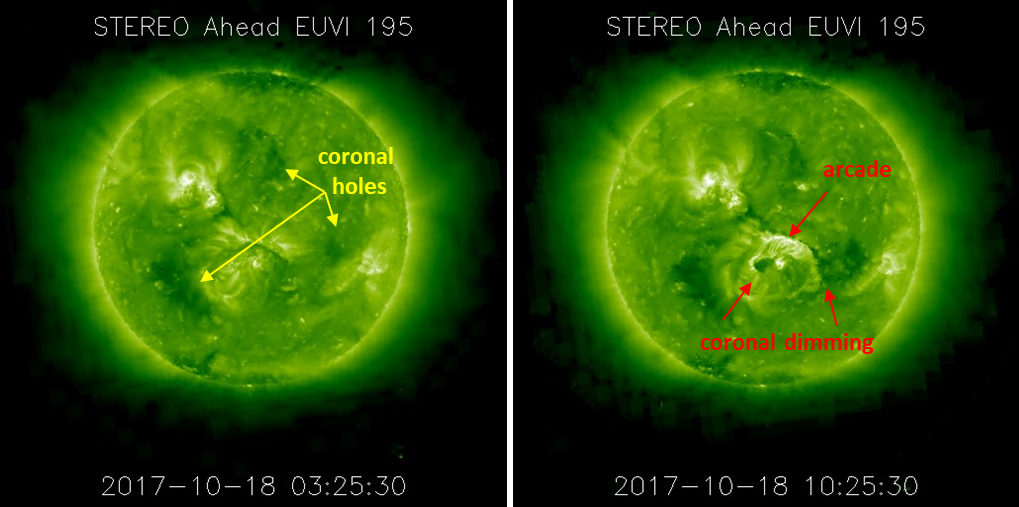
As mentioned in a previous news item, NOAA 2682 and its companion region NOAA 2683 became more active at the end of their previous transit over the earth-facing solar disk, about 2 weeks ago. CACTus analysis revealed CMEs from the Sun's farside on a regular base over the next 10 days, with either one of these two regions as their source. The intensity of the 18 October eruptions was nonetheless surprizing, with STEREO-A instruments even reporting a substantial increase in the number of energetic protons. Also the planet Mercury was well connected to the proton source region, whereas the GOES proton monitors near Earth reported only nominal levels.
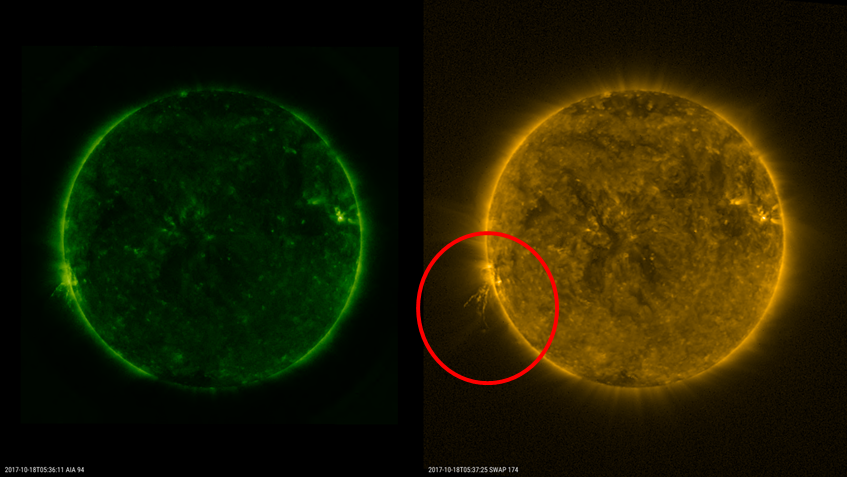
The first CME was seen in SOHO/LASCO C2 coronagraphic imagery at 05:48UT, and had a peculiar shape which was probably due to projection effects, and possibly somewhat deflected by nearby coronal holes. It was associated with radio bursts observed by various solar radio observatories around the world (daylight) during that time period, i.e. from 05:39UT till 05:45UT. SDO/AIA and PROBA2/SWAP imagery revealed a violent ejection of plasma (charged particles) from behind the solar limb starting around 05:35UT. Analysis revealed a speed of about 1500 km/s. The SDO/AIA 094 and PROBA2/SWAP images above show the ejection of material at resp. temperatures of several million and 1 million degrees at 05:37UT.
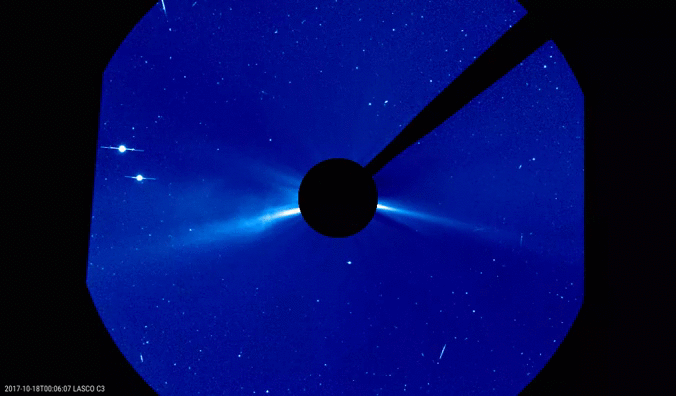
The second CME occurred in the aftermath of the first CME, and was already seen by SOHO/LASCO C2 starting around 06:50UT. Here, no radio bursts were reported by ground based observatories. SDO/AIA and PROBA2/SWAP imagery reveal a much milder ejection of plasma around this time. Analysis of SOHO and STEREO-A coronagraphic imagery gives a CME speed of about 1000 km/s. The SOHO/LASCO C3 clip above shows the bright second CME following close on the heels of the already fainted first CME. None of these CMEs are earth-directed, but STEREO-A will certainly be affected (asymmetric halo CME from its point of view). The two bright dots to the left are the planets Jupiter (top) and Mercury (bottom). Both are on the other side of the Sun as seen from Earth, at distances of resp. 964 and 213 million kilometers from our planet.
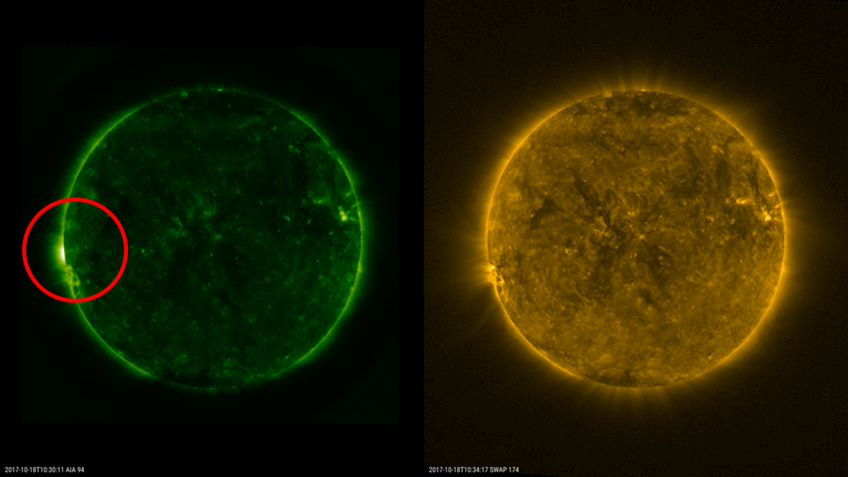
Despite NOAA 2682 being at least 2 days from rounding the east limb, the hot region on top of the developing post-eruption coronal loops towered high enough above the limb to gradually start influencing the GOES x-ray flux at Earth! A long duration event started around 08:30UT and peaked 2 hours later around 10:30UT at a modest B2.3. A brightening over the east limb can be seen in the multi-million degrees SDO/AIA 094 image above, but is absent in filters showing much cooler temperatures such as e.g. seen by PROBA2/SWAP.
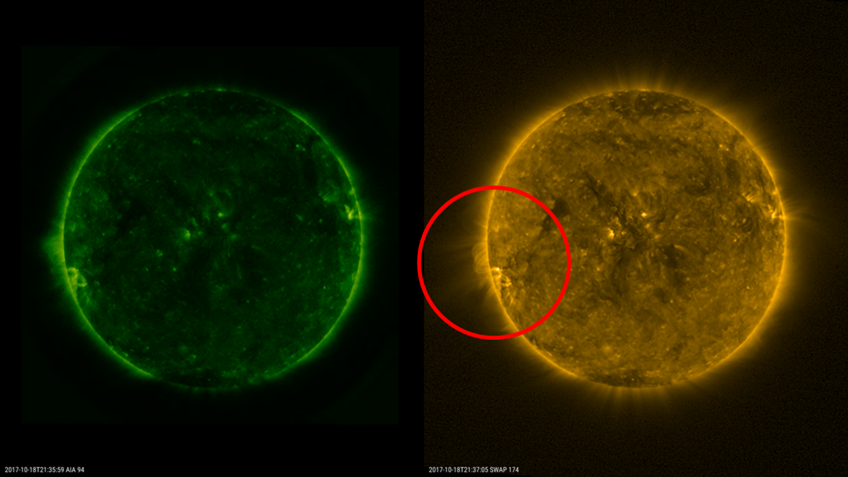
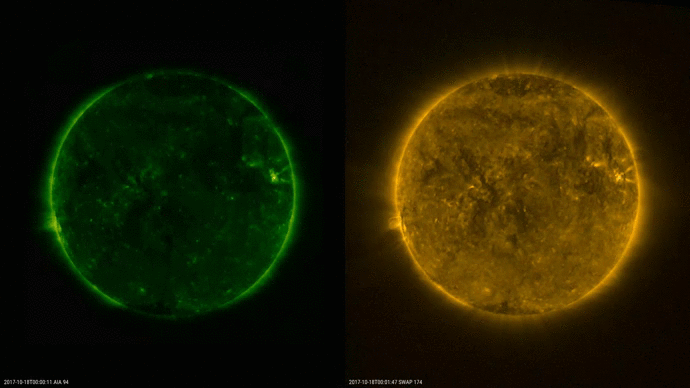
As the hot region gradually cooled down, the post-eruption coronal loops became visible from behind the limb. These loops were very well visible in PROBA2/SWAP images (see image above), as well as in SDO/AIA images with filters showing lower temperatures. They were about 70.000 km high (above the limb), corresponding to about 6 Earth diameters. STEREO-A EUV imagery shows a nice arcade, i.e. a series of post-eruption coronal loops.
Using JHelioviewer software, the movie below was created for the full day of 18 October (1 image every 6 minutes) integrating SDO/AIA 094 and PROBA2/SWAP imagery with timeline graphs from the e-Callisto network (radio bursts) and GOES (x-ray flux). The radio bursts are the fine yellow vertical threads around 05:45UT, the x-ray flux is the light blue curve at the bottom roughly between 09UT and 12UT.
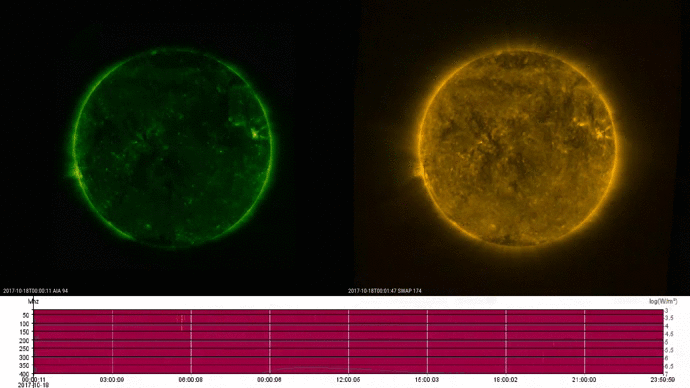
Exciting days are ahead. First of all to see the impact of the CMEs as they pass the STEREO-A spacecraft, both for the intensity as well as to see if the second CME can catch up with the first one. Indeed, although faster, the first CME has to plow through the much slower moving material of the undisturbed solar wind, allowing the second CME to run into its predecessor. The phenomenon is called "CME-cannibalism", and can lead to much stronger disturbances than if the CMEs would arrive separately. The CME pair is expected to arrive near STEREO-A late on 19 or early on 20 October. The second aspect is of course to see if NOAA 2682 and nearby NOAA 2683 will still be active when they round the east limb within a few days, and if they can increase the solar activity as seen from Earth.





